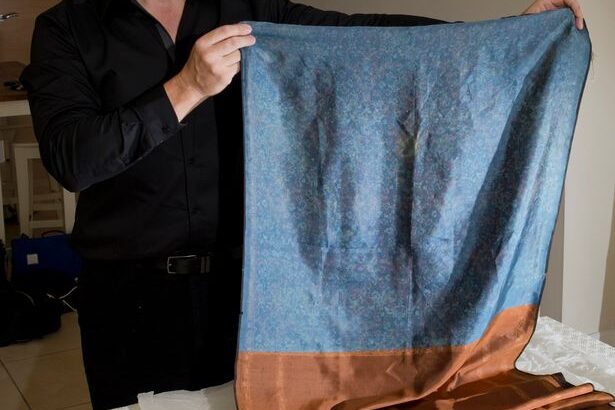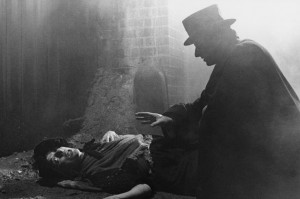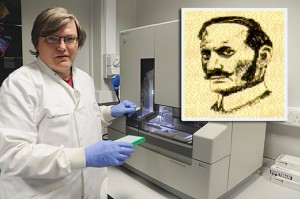After Russell Edwards read a story in the Mirror about one of the Ripper’s victims’ shawl going on sale, he was able to have the garment DNA tested and says it means the killer has been identified
Source : The Mirror
The true identity of Jack the Ripper has sensationally been revealed after new scientific evidence brought the 126-year-old mystery to an end.
DNA found on a shawl belonging to one of the notorious serial killer’s five victims proved a match for Polish suspect Aaron Kosminski.
He had been named as a prime suspect by the detective who led the hunt for the Ripper but there was never enough evidence to convict him.
The dramatic breakthrough came by chance after businessman Russell Edwards, 48, read a copy of the Daily Mirror in 2007.
He spotted a story about a shawl belonging to victim Catherine Eddowes was going on sale at auction and snapped it up for an undisclosed fee.
Found next to her body in the East End in September 1888, the blood stained material contained a treasure trove of evidence.
He enlisted the help of world-renowned genetic expert Dr Jari Louhelainen, who was able to extract DNA from the material.
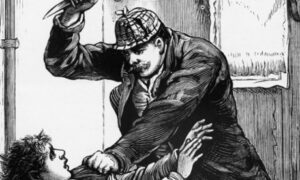
Illustration shows the police discovering the body of one of Jack the Ripper’s victims, probably Catherine Eddowes, London, England, late September 1888
The scientist first compared it to DNA from a descendant of Eddowes, which proved to be a match – achieving Russell’s goal of authenticating the item.
But he also found evidence of semen on the shawl and astonishingly matched it to DNA from an unnamed relative of prime suspect Kosminski.
The startling discovery finally unmasked Jack the Ripper – who terrorised the East End with the grisly murders of five prostitutes.
More than 100 suspects were wrongly identified as the Ripper – most famously Queen Victoria’s grandson, Prince Albert Victor, the Duke of Clarence.
Others included post-Impressionist painter Walter Sickert and former Liberal Prime Minister William Gladstone.
Russell said: “I initially just wanted to prove that the shawl was genuine. I never dreamed that I was actually going to solve the mystery. It’s quite overwhelming and moving that we can say with certainty to Kosminski was the Ripper. It’s been a long personal journey.”
Russell, from Birkenhead, Wirral, became fascinated with Jack the Ripper after watching the Johnny Depp film ‘From Hell’ in 2001.
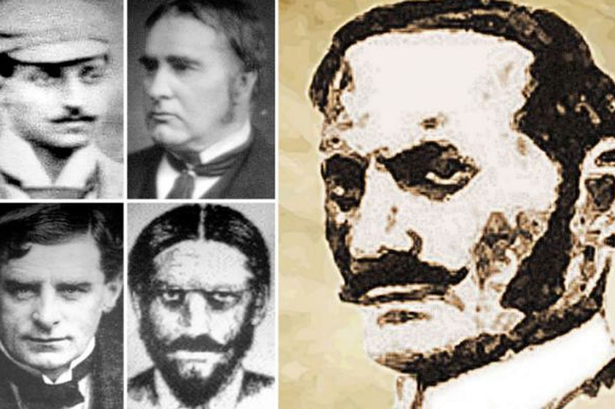
Suspects: Kosminski with Prince Edward, Walter Sickert, William Gull and John Pizer
http://www.mirror.co.uk/news/uk-news/jack-ripper-murder-mystery-how-4180390#ixzz3EyoqHPUv
Follow us: @DailyMirror on Twitter | DailyMirror on Facebook
At the time he lived a few streets away from his killer’s East End stomping ground and spent the next six years researching the case.
“I was a sort of armchair detective,” said Russell, a property developer who claims to have spent around £750,000 unraveling the mystery.
“But I’d pretty much given up on ever solving it to be honest, because all you could ever put forward was a theory.
“By chance I was reading a copy of the Daily Mirror in 2007 and spotted that Catherine Eddowes’ shawl was up for sale at auction.
“There was no evidence for its provenance and a previous forensic test had proved inconclusive, but I knew I had to buy it.”
The blood-splattered silk shawl, which featured a pattern of Michaelmas daisies at either end, was being sold by David Melville-Hayes,
He is a relative of Acting Sergeant Amos Simpson, who accompanied Catherine’s body to the morgue and was given the material for his seamstress wife.
Russell linked the Michaelmas daisies on the shawl to two dates for the Christian feast of Michaelmas on September 29 and November 8.
He was astonished to discover the dates matched with three murders – Eddowes and Elizabeth Stride were killed on September 29, while Mary Jane Kelly died on November 8.
“It was obvious Catherine wouldn’t have owned the shawl herself because she was too poor, but I though maybe the Ripper brought it as a clue,” he said.
“It was only a hunch but it was something only I had spotted and gave me the boost to set on my journey to discover the truth.”
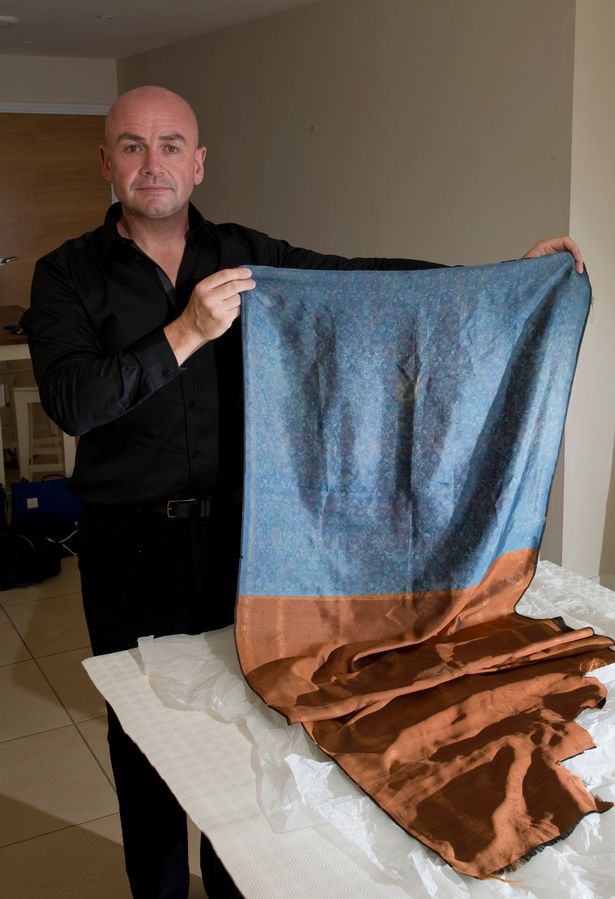
Russell Edwards, with a shawl found at the scene of Jack the Ripper’s 4th murder. The garment was passed down from a policeman who kept it. Russell has used DNA testing on stains found on the shawl to identify the killer – a polish-born Aaron Kosminski
Russell spoke to Alan McCormack, the officer in charge of Scotland Yard’s Crime Museum, who said the prime suspect had been Kosminski.
He was a Polish Jew who had fled to London with his family in the early 1880s to escape the Russian pogroms.
Chief Insp Donald Swanson, the officer in charge of the original case, named woman-hating Kosminski in his notes.
He was 23 and living with his two brothers and sister in Greenfield Street, just 200 yards from where Elizabeth Stride was killed, when the murders took place.
His name was first linked to the notorious case in 1894 and Swanson’s notes say an eyewitness picked him out but would not give evidence.
There was never enough evidence to charge the paranoid schizophrenic, but he was eventually committed to a mental asylum and died aged 53.
Russell enlisted the help of molecular biologist Dr Jari Louhelainen, a leading expert in genetic evidence from historical crime scenes.
He began tests on the shawl in 2011 and quickly realised that as well as blood splatters on the material, there were also semen stains.
“I was astonished,” said Russell. “I’d only set out to prove the shawl was genuine and here I was confronted with evidence of the Ripper himself.
“Jari told me the blood samples he had found were too old to extract DNA using the technique employed in current cases.
“Instead he used a pipette filled with a special liquid which removed the genetic material in the cloth without damaging it.
“I’m not a scientist so was totally relying on his skills, but it was still very hard to contain my excitement.”
The scientist told Russell that because of the age of the samples, he needed to use mitochondrial DNA – which is passed down through the female line.
That meant he was forced to begin another hunt – for a direct female descendant of Catherine who would be willing to give a DNA sample.
Miraculously Russell tracked down Karen Miller, the three-times great-granddaughter of Eddowes who agreed to provide a sample.
It was checked against the six DNA profiles Dr Louhelainen obtained from the blood on the shawl and all were a perfect match.
“It was an amazing moment,” he said. “It meant the item was genuine and was at the scene of that horrific crime in 1888.
“I knew we had the moment important Ripper artefact in history – something literally found at the scene of his crimes.
“But I also knew that the semen stains on the shawl belonged to the Ripper. Now we just had to find out if there was any DNA we could get.”
Dr Louhelainen spent another year trying to find surviving cells in the stains and made a successful breakthrough in 2012.
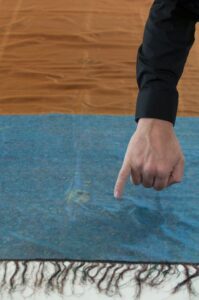
Russell Edwards, with a shawl found at the scene of Jack the Ripper’s 4th murder. Pictured blood stains on the shawl from the murder of Catherine Eddowes
Meanwhile Russell began the painstaking task of finding a female descendant of Kosminski’s sister who was willing to provide a sample.
“It was hard work but eventually I tracked down a woman who agreed to help. I promised not to name her because she was terrified of being linked to such an infamous case.
“She is British and gave me swabs from inside her mouth and they were given to Juri. He spent months checking and re-checking the DNA. I was on tenterhooks.
“And then in February this year I got an email from him confirming a match. I was speechless. I was so moved.”
The first strand of DNA tested proved to be a 99.2% match, but the second was a perfect 100% match.
Dr Louhelainen was even able to say the ethnic background of the DNA was Russian Jewish and established the person had dark hair.
“It was difficult to get my head round it all at first,” said Russell. “I had owned the shawl for seven years, and here was proof of the real identity of Jack the Ripper.
“I’ve been on a 14 year journey and could do with a holiday now to be honest.”
Asked about his plans for the shawl now, Russell said: “I want the world to see it. Hopefully it will go on display at the Crime Museum.
“I’m not saying how much I paid for it back in 2007, but I dare say it is worth a lot more money now.
“I’ve still got lots I want to know. I’d love to know the trigger for the killing spree. What caused such a monster to do what he did?”
Naming Jack the Ripper is published by Sidgwick & Jackson and costs £16.99 for a hardback

